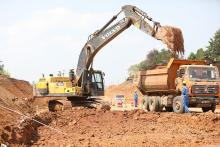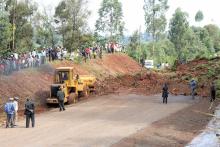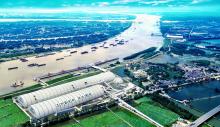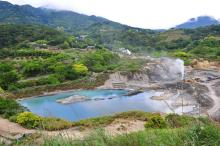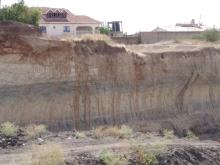
In recent years, increased Ugandan government spending on roads, dams, bridges, and housing has boosted the country’s construction sector, creating a huge appetite for sand and other building materials to support infrastructure development.The growing number of major Ugandan public infrastructure projects either underway or approved for development include the Standard Gauge Railway, the oil pipeline from Hoima to Tanga, the expansion of Entebbe Airport, and energy projects such as the Isimba and Karuma hydropower facilities.
Ugandan government spending on infrastructure increased by more than 120% between 2017 and 2020, with the administration allocating US$812mn, US$1.3bn, and US$1.8bn, respectively, to the works and transport sector between 2017 and 2019.
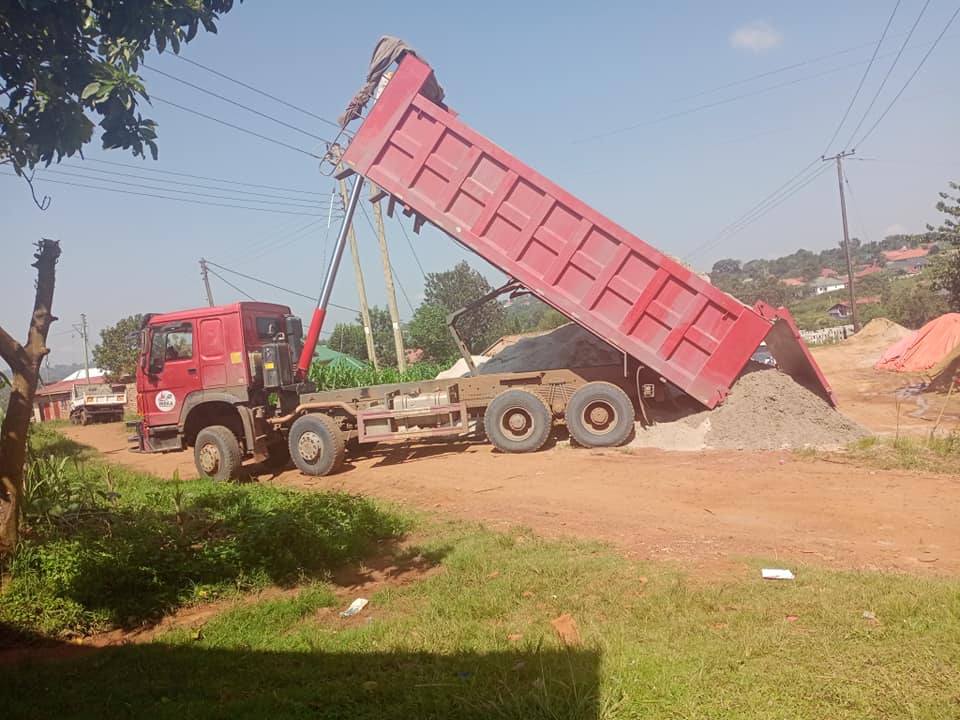
A recent Ugandan construction market report distributed by CISION PR Newswire said the average “input costs for the whole construction sector diminished by 2.85% for the year ending August 2020 compared to the 3.12% decrease recorded for July 2020 on account of COVID-19 restrictions and lockdowns.”
Although the budgetary allocation was reduced by 12% to US$1.6bn during 2020/21 on the back of the COVID-19 outbreak, Uganda has reaffirmed its determination to invest even more in a new and ambitious sand-consuming US$5.3bn urbanisation and housing programme initially slated for completion between 2020 and 2025.
The Sustainable Urbanisation and Housing Programme includes a US$3bn housing component that, according to the Ugandan government, will see an increase in “home ownership through the preparation and development of low-cost and affordable housing projects, slum upgrading, promotion of condominium development and public-private partnership in housing development.”
The Ugandan government is providing US$2.9bn, an equivalent of 52% of the total cost, while the private sector, including the country’s development partners, should contribute US$2.7bn or 48% of the programme costs.
Uganda has a housing deficit of over 2,000,000 housing units. However, the sector is seen as having significant backward and forward linkages, such as opportunities in the production of building materials, construction, maintenance and related service industries.
“It is important to note that since housing depends on other sectors such as the building materials industry and accompanying supply chain, transport and other related services, labour-supply skilled, semi-skilled and unskilled we believe that this demand will, in turn, create a need for employment in these industries with a resultant growth in GDP,” says Dorcas Okalany, technical head of a working group involved in the ambitious programme.
“With an estimated 300,000 housing units needed per year, commercial construction and residential construction in Uganda are booming,” says a report on Uganda’s construction industry investment opportunities by the US Department of Trade.
The housing construction boom is expected to grow as COVID-19 lockdowns and restrictions ease and projects are revived, increasing the extraction and consumption of sand.
According to Uganda’s National Environmental Authority (NEMA), there is now in Uganda “high demand for sand to support the construction sector and major infrastructural development projects such as roads, dams and bridges.”
A rebounding economy supports Uganda’s construction sector boom and corresponding sand consumption, with analysts predicting a 3.8% growth in 2022.
In early April 2022, Uganda’s Treasury Permanent Secretary Ramathan Ggoobi said the country’s economic rebound is driven by “continued recovery in production, consumption and employment and implementation of interventions to support households and business recovery.”
According to the Uganda Bureau of Statistics (UBOS), the country consumed an estimated 2,698,400 tonnes of cement in 2019 and another 3,240,000 tonnes in 2020.
Of this consumed cement, 13,600 tonnes and 13,800 tonnes were imported in 2019 and 2020, respectively. With no latest official sand production and consumption data in Uganda, one can derive usage estimates from the volumes of cement consumed in the local market using the ‘old thumb rule’ of one cement, two sand, and three gravel. This assumption means sand consumption for 2019 and 2020 may have reached 5,238,070 tonnes and 6,289,994 tonnes, respectively.
Previously, UBOS estimated Uganda’s sand production for 2015/2016 at 3.49 million tonnes, with artisanal and small-scale miners (ASMs) accounting for more than 90% of the production. Medium and large sand miners produced an estimated 349,100 tonnes in 2015/16, according to UBOS.
The trends show a likelihood the consumption could have been higher in 2020 save for the impact of the COVID-19 outbreak when some of the infrastructure project contractors were forced to declare ‘Force Majeure’ due to the COVID-19 pandemic as there was a “general material shortage for most projects which had not stacked enough,” according to Amadenc Tarmac, a construction firm specialising in small and medium road paving projects using asphalt and other modern materials.
The company said although Uganda classified the construction sector as an essential service when the government announced lockdowns in Uganda, the sector was not fully banned but “instead construction companies that had material on-site could continue operating normally as long as they adhere to standing regulations as provided by the ministry of health.”
Uganda relies heavily on its abundant rivers to extract sand compared to a few other sand-producing countries in Africa, such as Kenya, where sand is sourced not only from riverbeds but also from the sea and hilly areas.
Sand extraction in Uganda, which is dominated by ASMs, was for decades informally done using basic tools such as hoes and shovels.
However, sand-mining technology has increasingly gained traction in Uganda, with recent studies showing an evolving industry where the deployment of heavy excavators and dredgers is becoming popular.
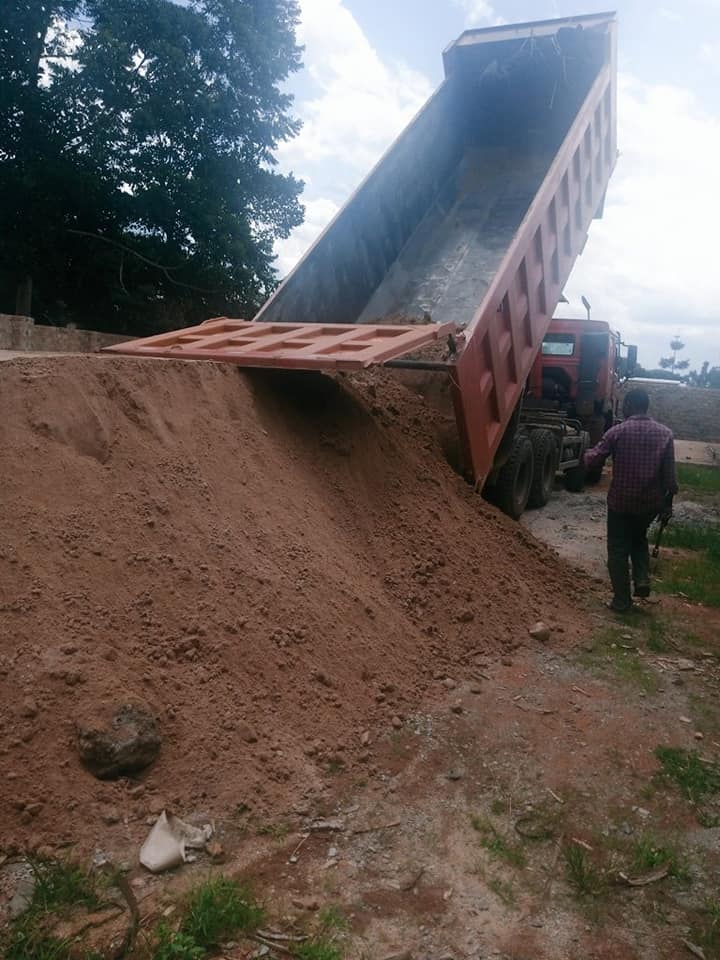
“From the year 2013, sand miners have been using sophisticated technology, particularly dredgers that extract massive volumes of sand in a short period of time,” says a recent report by a parliamentary committee on natural resources.
This technology upgrade, the committee found out, was largely driven by “increased demand for sand by the construction industry that has transformed sand mining into a commercial undertaking.”
The report cites the example of the sand-rich Lwera wetland, where “sand mining has increased, and the use of advanced technology has been on the rise.”
The use of excavators and dredgers is mostly associated with medium-scale miners, many of whom own or lease sand mines and can, therefore, carry out basic value addition such as sand selection and screening. Across Uganda, different sand types are priced differently.
While most of the Ugandan sand is used as fine-grained aggregate in the production of concrete, there are also deposits of glass-quality silica sand along the shores of, and on the islands within Lake Victoria such as Bukakata, Dimu, Nyimu, Nyabu, Nakimuli, Kome Island, Kabugoga and Entebbe.
“The Lake Victoria Basin is endowed with alluvial deposits that contain sand, a material that is in high demand by the construction industry,” says a September 2021 statement by NEMA.
The deposits of sand, NEMA adds, are deeper on the western side of Lake Victoria, especially around the areas of Lwera and Bukatata.
“The deposits of sand in the basin are deeper in the west, especially around Lwera and Bukatata, and it is therefore not surprising that out of all permitted sand-mining projects, over 80% of them are based in the west of the Lake Victoria basin, wholly in Lwera,” NEMA said.
With a negligible in-country glass-manufacturing capacity in Uganda, a large share of the sand extracted from these sites is used for construction purposes, mainly as the finer fraction of aggregate in cement production.
Various studies show the pricing of sand varying from region to region in Uganda, although the final price is determined by sand’s grade and quality. Sand considered to be of the highest quality, with a silica (SiO2) content of 99.95%, ideal for glass manufacturing, is mostly mined from Kome Islands and exported.
In fact, according to the parliamentary committee report, since sand is not a restricted export in Uganda under the Minerals (Prohibition of Exportation) Act, which only prohibits exportation of copper, an estimated 63,380kgs were exported from the country between 2012 and 2016, earning the exporters UGX 11.5mn (US$3,220), a figure some consider too low and linked to the lack of reliable production data and systematic valuation of Uganda’s total commercial sand output. No recent data was immediately available from URA.
In a further show of disparity in Uganda’s commercial sand market trends, one report by the Pretoria, South Africa-based Institute for Security Studies (ISS) has estimated Uganda’s 2015 sand exports to neighbouring countries at 22 tonnes, worth UGX253mn (US$68,500). The exports dropped to 19 tonnes, worth UGX16mn (US$4,300) the following year.
“The lack of accurate export data shows the difficulty of tracking illicit flows that often take place on the black market,” the ISS report says.
The Institute says there is a “lack of formalisation, investment and adequate government oversight”, hence opening a gateway to illegal transactions in Uganda’s overall mining industry.
Meanwhile, the parliamentary committee report identified Kenya, Canada, France, Tanzania and USA as some of the destinations for Uganda’s sand. Rolax International (U) Ltd exported the highest export volume during the period (15,000kgs) in 2013 to Kenya. The lowest quantity (3kgs) was exported by Tullow Uganda Ltd to Great Britain. None of these exporters was involved in sand mining. The URA could not meet a request for the latest sand export data.
Uganda’s sand mining is done by a mixture of local and foreign firms, with Chinese entities leading the pack of international sand extractors.
However, the number of investors mining sand and their identity are unclear due to the lack of systematic registration of sand businesses and work permits given to foreigners eyeing Uganda’s sand-industry investment opportunities.
Furthermore, concerns have continued to emerge about Chinese nationals and companies easily accessing land titles for sand-rich lands in Uganda, a process considered too complex for the locals.
Despite the haphazard operations of Uganda’s sand industry, NEMA says it is determined to regulate the mining of the natural resource “to ensure sustainable extraction of the resource.”
The authority says only licensed entities that have been subjected to a full Environmental and Social Impact Assessment (ESIA) process are allowed to extract sand on a commercial scale. The permits to extract the natural resources have specifications on “the maximum permissible depth of the resultant pit, a clearly demarcated area from where the sand will be extracted, and a compulsory requirement to restore the area before moving to another.”

At the basic informal level, the sand is generally extracted and sold collectively by the ASMs under a small team of leaders who then sell the harvested sand. The income is distributed equally among the members.
In cases where individuals own sand extraction sites, the sand is extracted by a group of workers under a team leader or the site owner. Once the sand is sold, the workers are paid per individual production. Many of these small sand-mining sites are also points of sale.
Channels for distribution of the sand include dealers or buyers bringing their own or leased lorries to the sand mines where, in most cases, the sand is normally sold by the truckload. The sand may be used directly by the first-tier buyer or may be taken to an urban point-of-sale centre and sold to other consumers.
Although it is not easy to access comprehensive data on registered sand-extracting companies in Uganda, previous records show a mixture of Ugandan and Chinese firms as the dominant players in the industry, with official records listing River Katonga Investments Ltd, Seroma Ltd, Parkson Hongkong Investments Ltd, Zhang Industries Ltd, Lukaya Sand Dealers, Tesco Industries, Capital Estates, Aqua World (U) Ltd, Mango Tree Group Ltd and He Sha Duo Co Ltd.
Currently, Uganda is pushing ahead with enacting a regulatory regime that would streamline the extraction, transportation, and trading in sand and safeguard the country’s wetlands from destruction through unsustainable sand extraction operations.
One of the recommendations of the parliamentary committee is the prioritisation of the passing of legislation that prescribes how the exploitation of substances such as sand, which are not classified as minerals for commercial purposes, should be done.
Uganda’s constitution does not classify sand as a mineral but has instead left it to parliament to enact appropriate regulations to capture the commercialisation of the natural resource.
Uganda has been attempting to enact laws for regulating the country’s sand market but in a rather slow manner. For example, it wasn’t until 2003 that parliament passed the Mining Act that classifies Uganda’s sand into two categories of building and industrial mineral. Yet, according to the ISS report, regulating the country’s sand market is hampered by “gaps in Uganda’s laws.”
“The new mining and minerals policy passed in 2018 gives only a basic legal framework [but] it doesn’t define small-scale artisanal sand miners who have often decried unclear licensing and regulating processes that target them rather than large-scale operators,” the Institute says.
Although the policy mandates NEMA and respective local governments where the sand mines are located to regulate and enforce sand mining rules, the ISS says sand, being a unique natural resource, “should not be governed only by mining and minerals policy.”
“A holistic policy is needed that regulates the activity and commerce of sand mining, and also protects water and land bodies where extraction takes place,” it adds.
Uganda’s sand industry is facing claims that it is damaging fish breeding grounds, leading to a decline in fish stocks, especially in Lake Victoria. Another challenge for the industry is the higher cost incurred from the need to mine deeper to extract sand from certain lake waters.
Lack of capacity on the part of NEMA, fuelled by inadequate funding, has been blamed for illegal activities within Uganda’s sand industry.
For example, NEMA cannot effectively certify the increasing technology now being deployed to extract sand and, therefore, cannot determine the actual extractable sand volumes.
In addition, NEMA has difficulties obtaining data on the actual sand extracted from sand mines across Uganda due to a lack of appropriate measuring equipment, translating to a shortage of accurate data and valuation of Uganda’s commercial sand production.
Nevertheless, NEMA is the approved state agency for issuing sand extraction permits in Uganda to both local and foreign sand miners that previously used to pay UGX100,000 (US$28) in addition to signing a commitment to restore sand borrowed pits, not to sell the leased wetland, ensure the sand mine is 200 metres from major highways, and only to extract sand that is at least 200 metres from protected zones of water bodies, especially lakes.
But even with these licensing regulations, illegal sand mining persists in Uganda due to a weak enforcement regime.
“Unregulated sand mining has prevailed in these areas in spite of the negative impacts of the activity on the environment such as fragmentation of the landscape resulting in open pits that are habitats for invasive aquatic plants like the water hyacinth and the Kariba weed,” NEMA said in September 2021, referring to the sand-rich areas of Mpigi, Gomba, Butambala and Kasanje in Wakiso district.
“Sand mining is an activity that must be regulated in order to ensure sustainable extraction of the resource,” said NEMA.
The ongoing infrastructure development boom in Uganda is enhancing sand’s premium. However, the uncertainty around regulating this otherwise highly lucrative natural resource is not only fuelling the emergence of illegal sand cartels in this landlocked country but could lead to the devastation of the nation’s environment in the long run. AB

